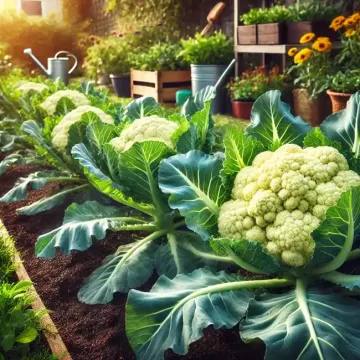Ideal Growing Conditions
Cauliflower thrives in cool weather, making it best suited for spring and fall gardening. It requires full sun but benefits from slightly shaded afternoons in warmer climates. Here are the ideal conditions for growing cauliflower:
- Temperature: Cauliflower prefers temperatures between 60-70°F (15-21°C). It struggles in heat, so planting during cooler months is essential.
- Soil: Rich, well-drained soil with a pH between 6.0 and 7.0 is ideal. Amend your soil with compost or well-rotted manure to improve fertility and drainage.
- Water: Keep the soil consistently moist but not waterlogged. Mulching around the plants helps retain moisture and keep the soil cool.
Planting Cauliflower
You can start cauliflower from seeds indoors or purchase transplants from a nursery. Here’s how to plant cauliflower:
- Starting Seeds Indoors: Start seeds indoors 4-6 weeks before the last expected frost. Plant seeds 1/4 inch deep in seed-starting mix. Keep the soil moist and maintain a temperature of 65-75°F (18-24°C). Once the seedlings have 2-3 true leaves, they can be transplanted outdoors.
- Transplanting: Transplant seedlings outdoors when they are 4-6 inches tall and the soil temperature is above 50°F (10°C). Space plants 18-24 inches apart in rows that are 24-30 inches apart.
- Direct Sowing: In mild climates, you can sow seeds directly in the garden in early spring or late summer. Sow seeds 1/4 inch deep, and thin seedlings to the recommended spacing once they are 4-6 inches tall.
Care and Maintenance
Proper care is crucial for growing healthy cauliflower. Here are some tips:
- Fertilization: Cauliflower is a heavy feeder. Apply a balanced fertilizer (e.g., 10-10-10) at planting and side-dress with compost or fertilizer every 4-6 weeks.
- Weeding: Keep the garden bed weed-free to reduce competition for nutrients. Mulching helps suppress weeds.
- Pest Control: Common pests include cabbage worms, aphids, and flea beetles. Use row covers to protect young plants and apply insecticidal soap or neem oil as needed.
- Blanching: To keep the curds white and tender, many gardeners practice blanching. When the head is about 2-3 inches in diameter, loosely tie the outer leaves over the curd to shield it from the sun.
Harvesting Cauliflower
Cauliflower is ready to harvest when the heads are firm, white, and compact, typically 7-12 inches in diameter. Harvest before the curds begin to separate or turn yellow. Use a sharp knife to cut the head off the plant, leaving a few leaves attached to protect the curd.
Common Challenges
Cauliflower can be sensitive to growing conditions. Here are some common issues and how to address them:
- Buttoning: This occurs when plants form small, premature heads. It’s often due to stress, such as temperature fluctuations or poor nutrition. Ensure consistent care to avoid buttoning.
- Riciness: If the curd appears grainy, it may be due to high temperatures or excessive nitrogen. Harvest promptly and maintain consistent soil moisture.
- Pests and Diseases: Regularly inspect plants for pests like cabbage worms and diseases like clubroot. Crop rotation and good garden hygiene can help prevent these problems.
Conclusion
Growing cauliflower in the home garden can be a bit of a challenge, but with the right conditions and care, it can also be incredibly rewarding. Whether you're a seasoned gardener or a beginner, following these guidelines will help you produce beautiful, delicious cauliflower heads that will enhance your meals and provide a sense of accomplishment. Happy gardening!

